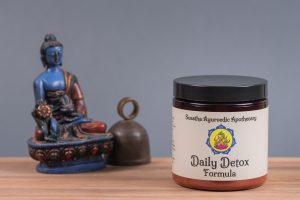 In Ayurveda, there are two main methods to establish balance, namely Shodhana (deep cleansing) and Shamana (gentle palliation). As useful and effective as Shodhana therapies can be, there are many instances in which deep cleansing should be avoided due to factors such as weakness, improper season, high stress, and even an excessively busy schedule. Luckily, Shamana therapies can be equally effective and much more gentle for the times when you just can’t handle a full-on cleanse.
In Ayurveda, there are two main methods to establish balance, namely Shodhana (deep cleansing) and Shamana (gentle palliation). As useful and effective as Shodhana therapies can be, there are many instances in which deep cleansing should be avoided due to factors such as weakness, improper season, high stress, and even an excessively busy schedule. Luckily, Shamana therapies can be equally effective and much more gentle for the times when you just can’t handle a full-on cleanse.
Discover “15 Reasons You Should Hold Off On Your Cleanse” here.
Shamana therapies focus mainly on balancing the three doshas (i.e. Vata, Pitta, Kapha); strengthening digestion; and (gently, slowly) flushing out toxins. These therapies can be done to prepare, strengthen, and balance the body before a cleanse; or they can be used in place of a cleanse altogether. Unlike Shodhana (deep cleansing) therapies, these gentler substitutes are generally safe for most individuals to perform on an ongoing, daily basis.
According to the ancient texts of Ayurveda, there are seven main therapies for Shamana. Although this knowledge comes from thousands of years ago, it still holds much truth for our modern lives and each therapy can be modified to meet your needs.
Here are a few common instances when Shamana therapies can be most helpful:
- During summer or winter, when the weather can be too hot or cold for a cleanse
- Before a cleanse, if there are excessively high toxins—gently cleansing the system will help prevent detox reactions and set the stage for a successful cleanse
- When any given dosha is too high to do a full-on cleanse—a relatively balanced state is necessary to handle the intense and uprooting nature of a cleanse
- When there is extreme weakness or debility, but toxins are high
- When you are too busy, overworked, or overstressed for a cleanse
Shamana Therapies: Gentle Cleansing Techniques For Everyday Life
1. Dipana – Igniting the Digestive Fire
WHY?
Since weak digestion is the primary cause of toxins (ama), imbalances (mental and physical), and disease, it is often the first line of action in all Ayurvedic treatment protocols. Incorporating digestion-enhancing therapies in your daily life will flush toxins, improve your metabolism, increase energy, and strengthen immunity.
HOW?
The most basic way to improve digestion is through digestive-stimulating herbs and herbal teas. In Ayurveda, digestive aids are generally taken directly before a meal to prepare the Agni (digestion) for the food to come. This helps to stimulate hunger, digestive enzymes, and metabolism.
Here are some effective herbal options to try:
- Agni Elixir – take one tablespoon before each meal in ½ cup of warm water
- Digestive Tonic Tincture – take 5 droppers in ½ cup of warm water before each meal
- Trikatu Churna – take ½ teaspoon mixed in 1 teaspoon honey (wash down with warm water) before meals
- Detox Tea or CCF Tea – Drink a cup 30 to 60 minutes before meals (get our CCF recipe here)
- Eat a thin slice of ginger before meals (or try this ginger, honey, and lime digestive appetizer recipe)
- Add ¼ teaspoon each of roasted cumin and fennel powder to a glass of warm water, add a splash of lemon and a pinch of salt; drink 15 to 30 minutes before meals
- Add 1 teaspoon of Apple Cider Vinegar and 1 teaspoon of honey to ½ cup of warm water and drink 15 to 30 minutes before meals (avoid for Pitta).
Here are a few general rules to promote healthy digestion:
- Add generous amounts of digestive spices to your meals
- Avoid improper food combinations (read more here)
- Eat for your dosha type (take our Dosha Quiz!)
- Avoid drinking liquids during and directly after meals (a few sips of warm water is fine)
- Avoid cold and iced beverages
- Make your largest meal midday; avoid eating heavy dinners
- End eating by 7 pm or earlier
2. Pachana – Burning Toxins
WHY?
There are many occasions where a cleanse is not suitable (too busy, too weak, wrong season, etc) but you are experiencing symptoms of toxic overload. Luckily, there are countless methods besides a full-on cleanse that help you burn toxins in a milder way.
There are also times when there is such a high level of toxins that performing a cleanse without the proper preparation will be too intense and lead to symptoms of a “detox reaction” (e.g. body ache, extreme brain fog, fatigue, nausea, fever, etc). To avoid stressing out and overloading your body, taking a month to gently flush your system before your cleanse will lead to much more successful and desirable results.
HOW?
There are plenty of ways to reduce your toxic load in a more sustainable, gentle manner. Taking the appropriate cleansing herbs is one of the most efficient methods, but looking into some gentle cleansing diet and lifestyle practices should be incorporated as well.
Here are some great places to start. You can begin these 2 to 4 weeks before a cleanse. If a cleanse is not recommended, you can practice several of these recommendations for 1 to 3 months and see the results for yourself!
- Take a cleansing herbal formula such as the Daily Detox Formula— ½ teaspoon, three times daily before each meal. Alternatively, you can take ¾ teaspoon, twice daily—upon awakening and before bed.
- Drink cleansing teas between meals—some examples include our Detox Tea and Tulsi Synergy Spice, or DIY Ginger Tea and CCF Tea.
- Take Triphala Churna before bed— ½ teaspoon in ½ cup of warm water.
- Eat a 100% whole food diet—completely eliminate all processed and packaged foods.
- Avoid all added sugar (white, cane, turbinado, raw, brown, date, coconut, etc, etc)—stick to using honey, fruit, and maple syrup as sweeteners.
- Lighten up your diet—limit or eliminate heavy foods such as red meat, pork, dairy, wheat, gluten, bread, pasta, pastries, etc.
- Avoid snacking and grazing—switch your snack habit to sipping on cleansing herbal teas between meals.
- EnJOY passive sweating! Take ginger baths and sauna soaks 3 to 5 times a week.
3. Kshut Nigraha – Mild Fasting
WHY?
Mild fasting and short-term mono-diet practices allow the digestion to rest and reset. This will promote a stronger digestive fire (Agni), alleviate digestive conditions, allow the body to process and eliminate toxins, support a healthy microbiome, and boost immunity. It also removes fogginess and encourages a sharp, clear mind.
HOW?
One of the most safe and effective methods for incorporating mild fasting techniques would be intermittent fasting. This is when you perform a mini-fast each day (consistently!) by avoiding any food consumption for 12 to 16 hours. Since it is extremely important to eat a nourishing breakfast each day and to avoid eating too late at night, I suggest eating your dinner meal by 4 to 6 pm and eating breakfast around 7 to 8 am.
Another way to incorporate mild fasting would be to observe a kitchari mono-diet for 1 to 3 days. For this, you can perform a one-day kitchari fast once a week for 4 to 12 weeks (or as long as needed). Or, if you prefer, you can perform a single and short kitchari fast for 2 to 3 consecutive days. This is generally short enough to be suitable for those who are too busy, weak, or are experiencing other situations where a cleanse is not recommended.
Read more on “How To Perform a Weekly Kitchari Fast”!
Read more on “How To Perform a 3-Day Kitchari Cleanse”!
Purchase our 3-day Kitchari Kit here.
4. Trut Nigraha – Minimizing Liquid Intake
WHY?
This recommendation is specific for individuals with high Kapha issues such as water retention, swelling, edema, type 2 diabetes, pulmonary edema, lymphatic congestion, and obesity. Reducing water intake until these conditions have subsided will help reduce the Kapha, swelling, and congestion while strengthening Ambu Vaha Srotas (the water-carrying channel).
HOW?
Depending on the severity of your condition, your environment, and the current season, it is recommended to reduce water intake to 3 to 4 cups of water daily. The water should be warm to hot and all cold beverages should be avoided. To stimulate the water channel further, you can take herbs such as Punarnava, Chitrak, and Gokshura.
5. Vyayama – Exercise
WHY?
There are countless reasons why exercise is essential for our health. In this context, exercise is a great support for detoxification as it promotes sweating, circulation, digestion, metabolism, and elimination.
HOW?
Every-body will have unique needs for their exercise regimen depending on their age, strength, level of health, pre-existing conditions, etc. Generally speaking, it is recommended to get 30 minutes of daily movement while making sure you are sweating and getting your heart rate up for at least 150 minutes a week (ideally spread out). Some great options include brisk walks, biking, hiking, swimming, mild Yoga, pilates, elliptical, light-weight training, and body weight exercises.
Discover the best exercises for each dosha here!
6. Atapa Seva – Sun Bathing
WHY?
In the proper context, sunlight promotes sweating and circulation. It provides us with vitamin D and supports healthy bones and strong immunity. It stimulates mental functioning and a positive mood and promotes clarity, focus, and concentration.
HOW?
Sunbathing should be done using caution and common sense. Individuals of a Pitta nature, a strong Pitta imbalance, or anyone with fair skin or a predisposition to skin cancer should avoid sunbathing altogether. For those that it is appropriate, it is recommended to get 5 to 20 minutes of direct midday sunlight with a large amount of your skin exposed (to absorb the vitamin D) each day.
If (like myself) sunbathing is not a good idea for you, you can replace this recommendation with regular infrared sauna soaks. This therapy is well known for its ability to support detoxification, increase circulation, promote digestion, boost immunity, and reduce inflammation. To really reap these benefits, I suggest soaking for 15 to 30 minutes 3 to 5 days a week (15 minutes for Pitta).
7. Maruta Seva – Taking in Fresh Air
WHY?
Taking in fresh air and practicing deep breathing enhances Prana, our vital lifeforce. It reduces stress and activates our Vagus Nerve and Parasympathetic Nervous System (aka our Rest and Digest Center). These vital practices balance the three doshas, promote circulation, enhance oxygenation, stimulate digestion, and increase our life span.
HOW?
This healing therapy involves inhaling fresh air and performing pranayama (breathing techniques). For the former, make sure you get outside each day by taking a walk, sitting in the park, or lying in the grass. At least once a week, you can enhance this healing therapy further by getting into nature, in the woods, mountains, or by a body of water.
Pranayama can be performed in many different ways. One of the simplest ways would be to sit comfortably and practice slow and deep belly breathing each morning, before bed, and throughout your day. If you are more experienced, tridoshic Pranayama techniques such as Nadi Shodhana and Anuloma Viloma are amazing options and can be done 2 to 3 times daily for 10 to 15 minutes per session.
Conclusion
Shamana therapies support detoxification, improve digestion, and bring balance to the body and mind. Unlike more intense cleansing programs, they are generally safe, gentle, easy to incorporate, and can be performed long-term by most individuals. These practices can be done individually, or for more benefit, done synergistically by choosing a few to focus on at a time. The best practices for you will depend on your specific needs. If you are new to Ayurveda or simply need some guidance, seeking out a knowledgeable Ayurvedic practitioner to work with intimately can be a great way to begin! When performed properly, Shamana therapies provide us with health, longevity, energy, and vitality.
Support digestion with our Agni Elixir!
Support detoxification with our Daily Detox Formula!
Discover 90 healing recipes with my 30-Minute Ayurvedic Cookbook!







Thank you for all that information! I have been actually doing some of these recently.
Hi Christina,
Wonderful! It is funny how our bodies know what we need if we listen properly.
I hope everything is going well for you! Let me know if any questions come up, and I will be happy to help.
Take it slow and be well:)
Namaste,
Danielle
Can we do a mini Panch Kriya monthly /weekly regularly like Oiling /Using Ghee for Orifices ie Apply Ghee as Nasya,Karna Poorana,Navel, drops in Anus ,Vagina for boosting Immunity, Energy Sleep for wear n Tear of Aging ? Specially post Menopause?
Hi Manisha,
Thanks for writing in! This would be a case-by-case question since everyone will have different needs. Generally speaking, nasya, karna purna, and massaging the vagina or anus with oil are all suitable for daily or weekly applications. Oil is often a great companion for women in their post-menopausal years due to the dryness that occurs during this stage of life.
I hope this helps! Let me know if you have any further questions.
Take it slow and be well:)
Namaste,
Danielle